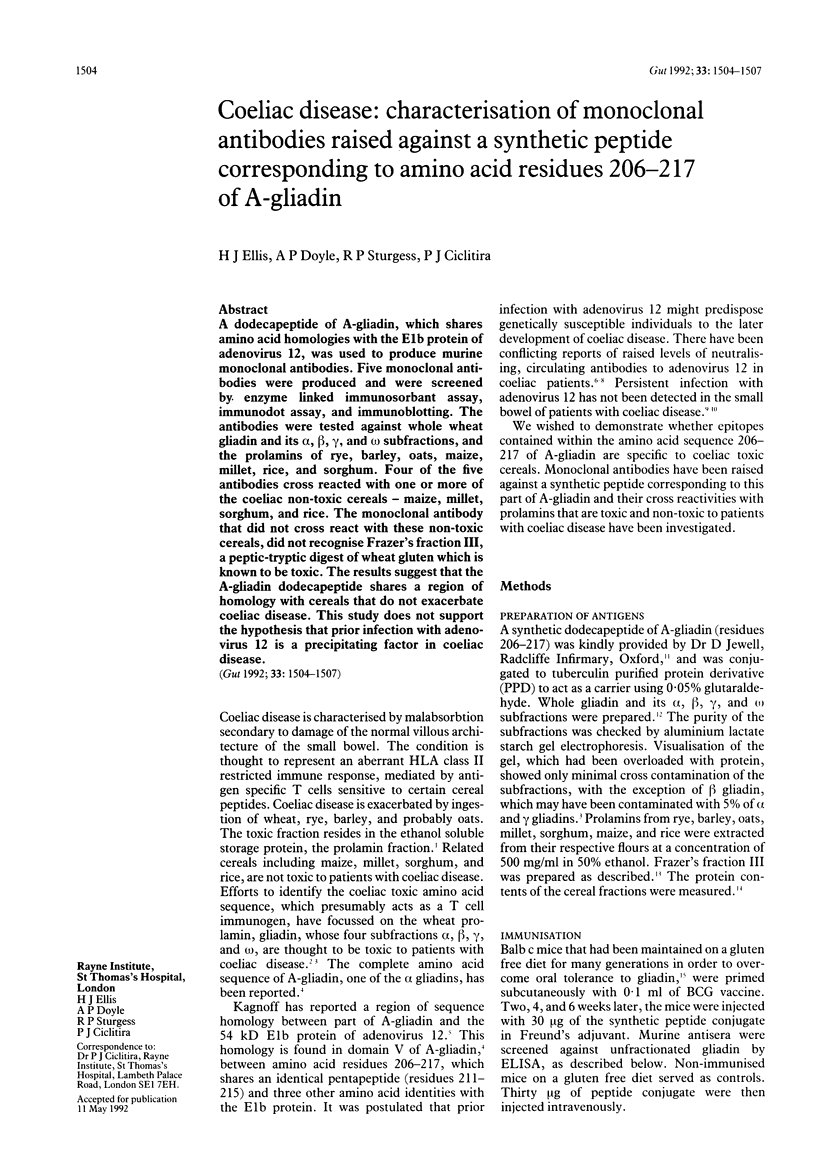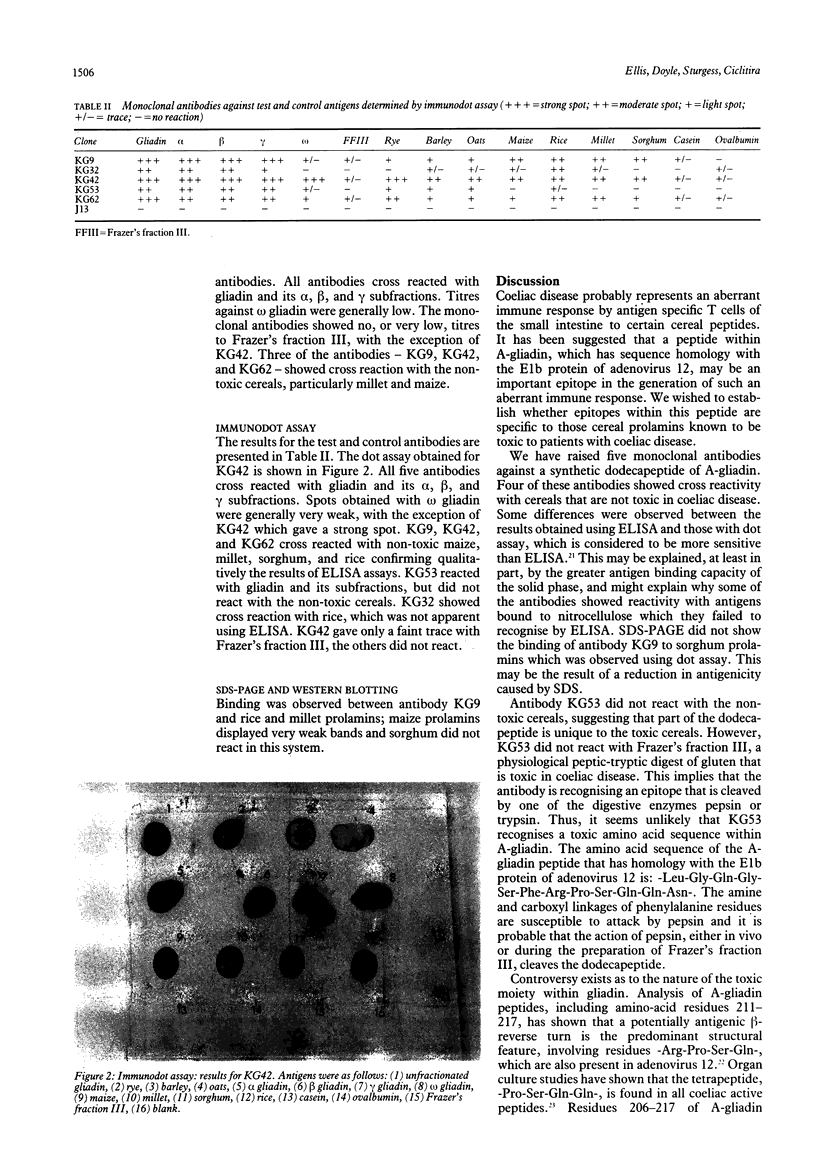Abstract
A dodecapeptide of A-gliadin, which shares amino acid homologies with the E1b protein of adenovirus 12, was used to produce murine monoclonal antibodies. Five monoclonal antibodies were produced and were screened by enzyme linked immunosorbant assay, immunodot assay, and immunoblotting. The antibodies were tested against whole wheat gliadin and its alpha, beta, gamma, and omega subfractions, and the prolamins of rye, barley, oats, maize, millet, rice, and sorghum. Four of the five antibodies cross reacted with one or more of the coeliac non-toxic cereals--maize, millet, sorghum, and rice. The monoclonal antibody that did not cross react with these non-toxic cereals, did not recognize Frazer's fraction III, a peptic-tryptic digest of wheat gluten which is known to be toxic. The results suggest that the A-gliadin dodecapeptide shares a region of homology with cereals that do not exacerbate coeliac disease. This study does not support the hypothesis that prior infection with adenovirus 12 is a precipitating factor in coeliac disease.
Full text
PDF



Images in this article
Selected References
These references are in PubMed. This may not be the complete list of references from this article.
- Carter M. J., Willcocks M. M., Mitchison H. C., Record C. O., Madeley C. R. Is a persistent adenovirus infection involved in coeliac disease? Gut. 1989 Nov;30(11):1563–1567. doi: 10.1136/gut.30.11.1563. [DOI] [PMC free article] [PubMed] [Google Scholar]
- Ciclitira P. J., Evans D. J., Fagg N. L., Lennox E. S., Dowling R. H. Clinical testing of gliadin fractions in coeliac patients. Clin Sci (Lond) 1984 Mar;66(3):357–364. doi: 10.1042/cs0660357. [DOI] [PubMed] [Google Scholar]
- Devery J. M., Bender V., Penttila I., Skerritt J. H. Identification of reactive synthetic gliadin peptides specific for coeliac disease. Int Arch Allergy Appl Immunol. 1991;95(4):356–362. doi: 10.1159/000235473. [DOI] [PubMed] [Google Scholar]
- Ellis H. J., Freedman A. R., Ciclitira P. J. The production and characterisation of monoclonal antibodies to wheat gliadin peptides. J Immunol Methods. 1989 Jun 2;120(1):17–22. doi: 10.1016/0022-1759(89)90283-4. [DOI] [PubMed] [Google Scholar]
- FRAZER A. C., FLETCHER R. F., ROSS C. A., SHAW B., SAMMONS H. G., SCHNEIDER R. Gluten-induced enteropathy: the effect of partially digested gluten. Lancet. 1959 Sep 5;2(7097):252–255. doi: 10.1016/s0140-6736(59)92051-3. [DOI] [PubMed] [Google Scholar]
- Freedman A. R., Galfre G., Gal E., Ellis H. J., Ciclitira P. J. Detection of wheat gliadin contamination of gluten-free foods by a monoclonal antibody dot immunobinding assay. Clin Chim Acta. 1987 Jul 15;166(2-3):323–328. doi: 10.1016/0009-8981(87)90436-0. [DOI] [PubMed] [Google Scholar]
- Freedman A. R., Galfre G., Gal E., Ellis H. J., Ciclitira P. J. Western immunoblotting of cereal proteins with monoclonal antibodies to wheat gliadin to investigate coeliac disease. Int Arch Allergy Appl Immunol. 1988;85(3):346–350. doi: 10.1159/000234530. [DOI] [PubMed] [Google Scholar]
- Galfrè G., Milstein C. Preparation of monoclonal antibodies: strategies and procedures. Methods Enzymol. 1981;73(Pt B):3–46. doi: 10.1016/0076-6879(81)73054-4. [DOI] [PubMed] [Google Scholar]
- Howdle P. D., Blair Zajdel M. E., Smart C. J., Trejdosiewicz L. K., Blair G. E., Losowky M. S. Lack of a serologic response to an E1B protein of adenovirus 12 in coeliac disease. Scand J Gastroenterol. 1989 Apr;24(3):282–286. doi: 10.3109/00365528909093047. [DOI] [PubMed] [Google Scholar]
- Howdle P. D., Ciclitira P. J., Simpson F. G., Losowsky M. S. Are all gliadins toxic in coeliac disease? An in vitro study of alpha, beta, gamma, and w gliadins. Scand J Gastroenterol. 1984 Jan;19(1):41–47. [PubMed] [Google Scholar]
- Kagnoff M. F., Austin R. K., Hubert J. J., Bernardin J. E., Kasarda D. D. Possible role for a human adenovirus in the pathogenesis of celiac disease. J Exp Med. 1984 Nov 1;160(5):1544–1557. doi: 10.1084/jem.160.5.1544. [DOI] [PMC free article] [PubMed] [Google Scholar]
- Kagnoff M. F., Paterson Y. J., Kumar P. J., Kasarda D. D., Carbone F. R., Unsworth D. J., Austin R. K. Evidence for the role of a human intestinal adenovirus in the pathogenesis of coeliac disease. Gut. 1987 Aug;28(8):995–1001. doi: 10.1136/gut.28.8.995. [DOI] [PMC free article] [PubMed] [Google Scholar]
- Karagiannis J. A., Priddle J. D., Jewell D. P. Cell-mediated immunity to a synthetic gliadin peptide resembling a sequence from adenovirus 12. Lancet. 1987 Apr 18;1(8538):884–886. doi: 10.1016/s0140-6736(87)92859-5. [DOI] [PubMed] [Google Scholar]
- Kasarda D. D., Okita T. W., Bernardin J. E., Baecker P. A., Nimmo C. C., Lew E. J., Dietler M. D., Greene F. C. Nucleic acid (cDNA) and amino acid sequences of alpha-type gliadins from wheat (Triticum aestivum). Proc Natl Acad Sci U S A. 1984 Aug;81(15):4712–4716. doi: 10.1073/pnas.81.15.4712. [DOI] [PMC free article] [PubMed] [Google Scholar]
- Kearney J. F., Radbruch A., Liesegang B., Rajewsky K. A new mouse myeloma cell line that has lost immunoglobulin expression but permits the construction of antibody-secreting hybrid cell lines. J Immunol. 1979 Oct;123(4):1548–1550. [PubMed] [Google Scholar]
- LOWRY O. H., ROSEBROUGH N. J., FARR A. L., RANDALL R. J. Protein measurement with the Folin phenol reagent. J Biol Chem. 1951 Nov;193(1):265–275. [PubMed] [Google Scholar]
- Mahon J., Blair G. E., Wood G. M., Scott B. B., Losowsky M. S., Howdle P. D. Is persistent adenovirus 12 infection involved in coeliac disease? A search for viral DNA using the polymerase chain reaction. Gut. 1991 Oct;32(10):1114–1116. doi: 10.1136/gut.32.10.1114. [DOI] [PMC free article] [PubMed] [Google Scholar]
- Mantzaris G. J., Karagiannis J. A., Priddle J. D., Jewell D. P. Cellular hypersensitivity to a synthetic dodecapeptide derived from human adenovirus 12 which resembles a sequence of A-gliadin in patients with coeliac disease. Gut. 1990 Jun;31(6):668–673. doi: 10.1136/gut.31.6.668. [DOI] [PMC free article] [PubMed] [Google Scholar]
- Mantzaris G., Jewell D. P. In vivo toxicity of a synthetic dodecapeptide from A gliadin in patients with coeliac disease. Scand J Gastroenterol. 1991 Apr;26(4):392–398. doi: 10.3109/00365529108996500. [DOI] [PubMed] [Google Scholar]
- Patey A. L., Evans D. J. Large-scale preparation of gliadin proteins. J Sci Food Agric. 1973 Oct;24(10):1229–1233. doi: 10.1002/jsfa.2740241011. [DOI] [PubMed] [Google Scholar]
- Tatham A. S., Marsh M. N., Wieser H., Shewry P. R. Conformational studies of peptides corresponding to the coeliac-activating regions of wheat alpha-gliadin. Biochem J. 1990 Sep 1;270(2):313–318. doi: 10.1042/bj2700313. [DOI] [PMC free article] [PubMed] [Google Scholar]
- VAN DE KAMER J. H., WEIJERS H. A., DICKE W. K. Coeliac disease. IV. An investigation into the injurious constituents of wheat in connection with their action on patients with coeliac disease. Acta Paediatr. 1953 May;42(3):223–231. doi: 10.1111/j.1651-2227.1953.tb05586.x. [DOI] [PubMed] [Google Scholar]
- de Ritis G., Auricchio S., Jones H. W., Lew E. J., Bernardin J. E., Kasarda D. D. In vitro (organ culture) studies of the toxicity of specific A-gliadin peptides in celiac disease. Gastroenterology. 1988 Jan;94(1):41–49. doi: 10.1016/0016-5085(88)90607-5. [DOI] [PubMed] [Google Scholar]



